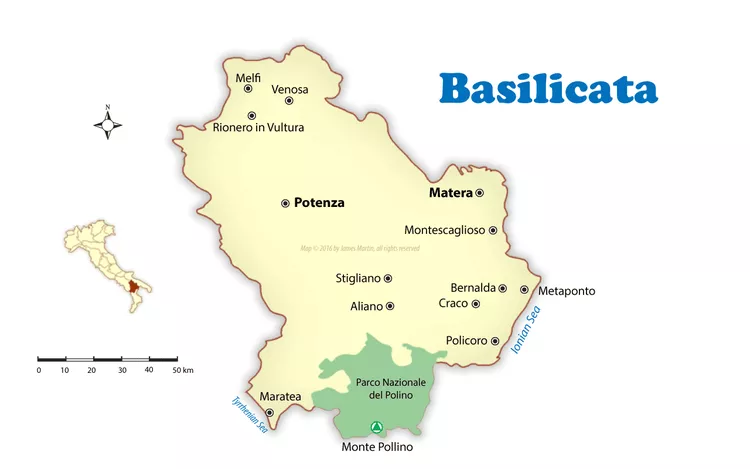Summary
Basilicata, the instep of the boot, is an off the tourist track region in southern Italy. A mountainous area with a jagged, rocky coastline on the Tyrrhenian coast and another on the Ionian Sea. Basilicata, like the neighboring Calabria and Puglia regions, has been home to many cultures; you’ll see evidence of Greek colonization at Metaponto and Policoro, Roman towns, Norman castles, and cave dwellings that have been used since prehistoric times.
Exploring the Basilicata Region
The Parco Nazionale del Pollino in the south extends around Monte Pollino, 2248 meters high. Furthermore, 24 Basilicata towns and four nature reserves can be found in the park, part of which goes into Calabria.
Basilicata is best explored by car; however, the inland cities of Melfi, Potenza, and Matera, along with the coastal towns of Maratea and Metaponto, can be reached by train, although service is fairly limited. From these towns, there is bus service to smaller towns nearby.
The Basilicata region is divided into two provinces: Potenza to the west and Matera to the east, with their capital cities marked on the map in capital letters.
Basilicata Cities to Visit

Matera and Its Province
A fascinating city in Basilicata, and probably the most developed for tourists, is Matera with its Sassi district of cave houses and over 100 rock churches, a UNESCO World Heritage Site. Matera has served as the backdrop for many films, including Pasolini’s The Gospel According to St. Matthew and Mel Gibson’s The Passion of the Christ (2004). If you’re visiting during the summer, do not miss its renowned festival, the Festa della Madonna Bruna on July 2nd.
Montescaglioso is a hill town that was the center of the Norman Kingdom of Sicily. The top sight is Montescaglioso’s 11th-15th century Abbey of San Michele Arcangelo. Additionally, the town hosts the colorful Festa di San Rocco in August, which features a religious parade and fireworks.
Bernalda, made famous by Francis Ford Coppola, is a lively town with a small historic center that includes a castle and a long main street lined with restaurants, bars, and shops. It provides an excellent base for visiting Matera, Craco, Metaponto, and the coast.
Craco is one of Italy’s most notable ghost towns. Once a thriving hill town, it was mostly abandoned following a mudslide. Be sure to stop by the visitor center for an eerie yet fascinating guided tour (available in English).
Metaponto is a renowned Greek settlement on the Ionian coast, formerly known as Metapontum. Archaeological enthusiasts should visit the Museo Archeologico Nazionale and the nearby ruins, which include a Greek temple. Metaponto also boasts a fine white sand beach.
Policoro features the famous Lido di Policoro beach and the ruins of the Greek settlement of Heraclea located on the outskirts of town.
Stigliano serves as a great starting point for exploring the Basilicata mountains.
Aliano is known as the town where Carlo Levi was exiled. Visitors can explore his house and admire the stunning landscape he vividly described in his book Christ Stopped at Eboli.
Western Basilicata Towns to Visit, Potenza Province
Maratea, situated on the slopes of Monte San Biagio, features a charming historic center, beautiful beaches, and an inviting port. Marina di Maratea is located on the Tyrrhenian coast, a wild and rocky coastline that offers an appealing alternative to the more touristy Amalfi Coast.
Melfi has a rich history, having been a Roman and then a Longobard city before becoming Norman. Visitors can explore the Norman castle and baroque cathedral alongside the Bishop’s Palace, Palazzo del Vescovado. Inside the castle is the Museo Nazionale Archeologico Melfese, an excellent archaeology museum with significant collections from the surrounding area. Melfi is accessible via the rail line.
Venosa was once a Roman town known as Venusia and is the birthplace of the poet Horace. The town features a 15th-century Aragonese castle, a Baroque Church of the Purgatory, and the Palaeolithic era is represented by the Archaeological Area of Notarchirico, where a Homo Erectus femur fragment was discovered.
Rionero in Vulture has been established since at least 290 BC and was seized by the Normans around 1041. The towns in the Vulture area sit under the shadow of Monte Vulture, an extinct volcano providing fertile soil for the region. Aglianico del Vulture is a notable DOC wine produced in the area.
Potenza is a modern city that faced substantial destruction from World War II bombings and earthquakes, although some remnants of the old town still remain. Notably, only one tower of the castle remains intact, and the old cathedral was restored in the 18th century. A 17th-century mansion, Palazzo Loffredo, houses the archaeological museum, alongside the remains of a Roman villa.





